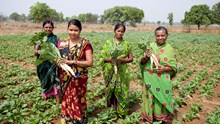
Guinea fowl (Numida meleagris) is increasingly seen as an ideal poultry bird for meat production in agro-climatic regions like Northeast India. The meat is lean, rich in vitamins, and has a gamey flavor akin to wild birds. It is especially suited for tribal farming communities due to the bird’s resistance to common poultry diseases, minimal housing requirements, and compatibility with low-input systems. The three commonly domesticated varieties, pearl, white, and lavender, offer both aesthetic and commercial value, with the purplish pearl being the most prevalent.
Another breed of guinea fowl that is quite popular is the Numida ptilorhyncha which has a collateral feather on its upper neck. Both Numida meleagris and Numida ptilorhyncha have a lot of potential in the market.
Characteristics and Advantages
Guinea fowl exhibit several distinct traits:
-
Physical Features: They have featherless heads and necks with wattles—more pronounced in males. Their gregarious nature makes them sensitive to sudden movements and sounds.
-
Temperament: They are more closed-natured and noisier than chickens, which can be both a disadvantage in residential areas and a benefit in agricultural settings where their alert calls act as a deterrent to predators.
-
Adaptability: These birds are heat-tolerant, stress-resistant during transportation, and thrive in a variety of agro-climatic zones. They are particularly effective foragers and require less commercial feed compared to chickens.
-
Disease Resistance: Guinea fowl show strong resistance to common poultry diseases, making them cost-effective for rural or semi-urban farmers.
Systems of Rearing
There are three main systems for Guinea fowl rearing:
-
Free-Range System: Practiced by resource-poor farmers, birds forage during the day and are provided water and minimal protection. While cost-effective, this system can lead to crop damage due to their pecking behavior.
-
Semi-Free Range: In this system, the chicks, known as keets, are initially housed at a density of 1000 keets per 24 square meters. They are later moved to a rearing facility that includes a 40 square meter shelter and a 200 square meter aviary equipped with perches. This area is connected to an open space enclosed with wire fencing that stands 1.5 to 2 meters high. For breeding purposes, it is essential to pinion the keets which involves either tying their wings or clipping one wing to prevent them from flying and ensure controlled movement within the enclosure.
-
Intensive System: Suitable for commercial production, this system uses dark houses to minimize stress. Birds are housed at densities of 3–5 per square meter with perches, and controlled breeding through artificial insemination is practiced.
Breeding and Egg Production
Sexing Guinea fowl is challenging due to their similar appearance. However, differences emerge after two months, males have larger wattles and helmets, and their calls differ from females.
-
Maturity: Guinea hens begin laying at 16–17 weeks and can lay around 100 eggs annually.
-
Seasonality: In tropical climates, egg-laying peaks during the rainy season. Hens can go broody after laying 30 eggs.
-
Fertility and Hatchability: With a fertility rate of 75–80%, eggs incubate over 26–28 days. Crosses with domestic roosters (producing sterile “Guin-hens”) have a shorter incubation of 24–25 days.
-
Egg Collection: Eggs should be collected multiple times daily, stored at 15.5–18.5°C, and not held for more than 7 days to maintain hatchability.

Brooding and Growing Keets
Newly hatched keets weigh about 24.6 grams. Brooding begins at 37°C, reducing by 4°C weekly. Stocking density should be 20 keets/m² initially, then halved after a few weeks.
Growth and Feed Conversion:
-
At 11 weeks, keets weigh about 1.37 kg, having consumed around 4.1 kg of feed.
-
At 13 weeks, they reach about 1.58 kg with an FCR (feed conversion ratio) of 3.39.
-
Males grow slightly faster than females and are ready for market between 12–16 weeks.
Feeding and Nutrition
Guinea fowl are natural scavengers, consuming weed seeds, insects, worms, berries, and small animals. This trait makes them ideal for integrated farming systems.
Recommended Feeding Regimen:
-
Starter Diet (0–4 weeks): 24% crude protein
-
Grower Diet I (5–8 weeks): 20% crude protein
-
Grower Diet II (9–14 weeks): 16% crude protein
-
Breeder Diet (from 14 weeks onward): 16% crude protein with elevated calcium for egg production
Lifetime Feed Consumption:
-
Growing period: 12 kg
-
Laying period: 3 kg
-
Total: 43 kg
A slight increase in lysine and methionine is recommended over standard poultry feed formulations to support their rapid growth and reproductive performance.
Housing and Environmental Needs
Though Guinea fowl are robust, good housing significantly improves productivity:
-
Perches: Crucial to reduce panic-induced crowding.
-
Lighting: Low-intensity lighting helps reduce stress and aggression.
-
Ventilation: Must be adequate, especially in intensive systems.
-
Brooder and Rearing Areas: Should ensure sufficient space, hygiene, and predator protection.
Marketing and Economic Potential
Guinea fowl reach market weight (1.25–1.47 kg) by 15 weeks. Their meat is leaner and drier than chicken, appealing to health-conscious consumers and those with a preference for game meat.
Apart from being sold as meat birds, they also serve ornamental purposes or are reared as game birds. Their growing popularity in speciality markets can command premium pricing, particularly for organically reared or free-range birds.
Guinea fowl rearing offers a sustainable and economically viable poultry alternative, especially for rural and tribal communities in India. With minimal input costs, high adaptability, and good market potential, it holds promise both as a backyard venture and as a scalable enterprise. The key to success lies in proper management, especially during the brooding and growing phases and in tapping into niche markets that value this unique bird.
By integrating Guinea fowl into existing farming systems, farmers can enhance biodiversity, reduce feed costs through scavenging, and tap into an emerging market with a growing demand for alternative poultry products.
















